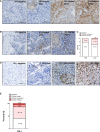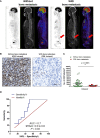Clinical implications of immune checkpoint markers and immune infiltrates in patients with thymic neuroendocrine neoplasms
- PMID: 36203421
- PMCID: PMC9531766
- DOI: 10.3389/fonc.2022.917743
Clinical implications of immune checkpoint markers and immune infiltrates in patients with thymic neuroendocrine neoplasms
Abstract
The potential response of immune checkpoint blockade (ICB) in thymic neuroendocrine neoplasms (T-NEN) is largely unknown and full of great expectations. The expression of immune checkpoint molecules and immune infiltrates greatly determine the response to ICB. However, studies regarding the immune landscape in T-NEN are scarce. This work was aimed to characterize the immune landscape and its association with clinical characteristics in T-NEN. The expression of programmed cell death protein 1 (PD-1) and its ligand, programmed death ligand-1 (PD-L1), and the density of tumor-infiltrating lymphocytes (TILs), monocytes, and granulocytes were determined by immunohistochemical (IHC) staining on tumor tissues from T-NEN. Immune landscapes were delineated and correlated with clinicopathological factors. We found that T-NEN with increased immune cell infiltration and enhanced expression of PD-1/PD-L1 tended to have restricted tumor size and less metastases. A higher density of CD8+ TILs was associated with a significantly lower rate of bone metastasis. In addition, we presented three cases of T-NEN who progressed after multiple lines of therapies and received ICB for alternative treatment. ICB elicited durable partial responses with satisfactory safety in two patients with atypical carcinoid, but showed resistance in 1 patient with large cell neuroendocrine carcinoma. This innovative study delineated for the first time the heterogeneous immune landscape in T-NEN and identified CD8+ TILs as a potential marker to predict bone metastasis. An "immune-inflamed" landscape with the presence of TILs predominated in T-NEN, making T-NEN a potentially favorable target for ICB treatment. Further judicious designs of "tailor-made" clinical trials of ICB in T-NEN are urgently needed.
Keywords: immune checkpoint blockade; immune infiltrates; programmed death ligand-1; programmed death-1; thymic neuroendocrine neoplasms.
Copyright © 2022 Liu, Hu, Zhang, Zhang, Chen, Lin, Wang, Luo, Guo, Chen and Chen.
Conflict of interest statement
The authors declare that the research was conducted in the absence of any commercial or financial relationships that could be construed as a potential conflict of interest.
Figures





Similar articles
-
PD-L1 Expression and Immune Cell Infiltration in Gastroenteropancreatic (GEP) and Non-GEP Neuroendocrine Neoplasms With High Proliferative Activity.Front Oncol. 2019 May 7;9:343. doi: 10.3389/fonc.2019.00343. eCollection 2019. Front Oncol. 2019. PMID: 31134150 Free PMC article.
-
Antitumor immune response is associated with favorable survival in GEP-NEN G3.Endocr Relat Cancer. 2021 Sep 2;28(10):683-693. doi: 10.1530/ERC-21-0223. Endocr Relat Cancer. 2021. PMID: 34472429
-
Stromal PD-L1-Positive Regulatory T cells and PD-1-Positive CD8-Positive T cells Define the Response of Different Subsets of Non-Small Cell Lung Cancer to PD-1/PD-L1 Blockade Immunotherapy.J Thorac Oncol. 2018 Apr;13(4):521-532. doi: 10.1016/j.jtho.2017.11.132. Epub 2017 Dec 18. J Thorac Oncol. 2018. PMID: 29269008
-
Biomarkers of Immune Checkpoint Blockade Response in Triple-Negative Breast Cancer.Curr Treat Options Oncol. 2021 Mar 20;22(5):38. doi: 10.1007/s11864-021-00833-4. Curr Treat Options Oncol. 2021. PMID: 33743085 Review.
-
The Progress of Immunotherapy in Refractory Pituitary Adenomas and Pituitary Carcinomas.Front Endocrinol (Lausanne). 2020 Dec 11;11:608422. doi: 10.3389/fendo.2020.608422. eCollection 2020. Front Endocrinol (Lausanne). 2020. PMID: 33362722 Free PMC article. Review.
Cited by
-
Recent Clinical and Molecular Advances in the Management of Thymic Carcinoids: A Comprehensive Review.Cancers (Basel). 2025 Jun 13;17(12):1975. doi: 10.3390/cancers17121975. Cancers (Basel). 2025. PMID: 40563625 Free PMC article. Review.
-
Preliminary analysis of immune-related markers in thymic carcinoid.J Transl Med. 2023 Dec 9;21(1):894. doi: 10.1186/s12967-023-04751-x. J Transl Med. 2023. PMID: 38071307 Free PMC article.
References
-
- WHO Classification of tumors Editorial Board . Thoracic tumors. In: WHO classification of tumors, 5th edition, volume 5. IARC Press World Health Organization. (2021).
LinkOut - more resources
Full Text Sources
Research Materials

